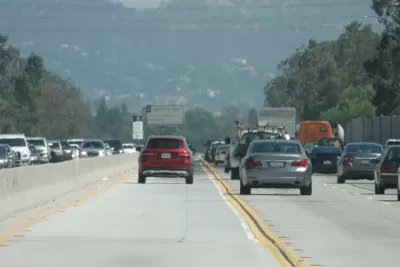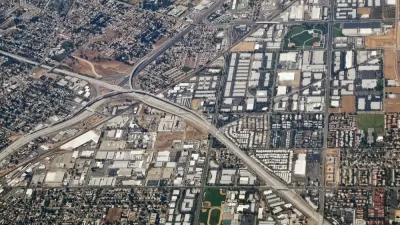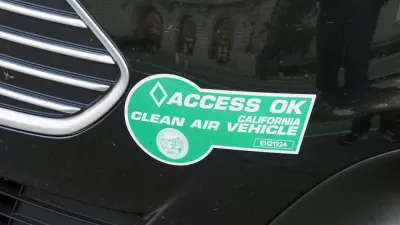Construction of 10 miles of dual express lanes on I-10 received the go-ahead last month after a TIFIA loan closed for $225 million of the $925 million project planned by the San Bernardino County Transportation Authority.

The U.S. Department of Transportation’s Build America Bureau, which promotes transportation infrastructure development projects in the United States by facilitating financing opportunities, finalized a direct loan of $225 million for the Interstate 10 Corridor Project in San Bernardino County, according to a press release posted by InlandEmpire.US on May 2.
Planned by the San Bernardino County Transportation Authority (SBCTA), construction of the approximately 10 miles of express lanes along the I-10 in each direction from the Los Angeles County line to Interstate 15 will start early next year. The express lanes, which should open for service in 2023, will apply congestion pricing to toll-paying single-occupant-vehicles and be free to carpools of three or more occupants.
The low-interest federal loan, which closed on Friday [April 26], is through the Transportation Infrastructure Finance and Innovation Act (TIFIA) and represents about one-fourth of the project’s overall $929 million anticipated cost.
“The closing of the TIFIA loan is a major milestone for the I-10 Corridor Project and underscores the importance of that stretch of interstate to the entire country," said Rep. Pete Aguilar (D-Redlands). "As the Inland Empire’s economy and population continue to grow, it’s important that we find ways to increase mobility throughout the region."
Population projections show the Inland Empire growing from 4.5 million to 7 million people within 30 years.
Tolls make project viable
"The TIFIA loan will be repaid primarily from toll revenues generated by the project," states a Sentinel News Service article on the funding award.
Motorists and legislators may not like tolls, but when the project was planned, there wasn't funding available to widen the interstate with general purpose (unpriced and unmanaged) or carpool lanes.
Former Assemblywoman Cheryl Brown, D-San Bernardino, who introduced the enabling legislation in February 2015 to allow the San Bernardino County Transportation Commission, the predecessor of SBCTA, to build and operate the I-10 toll lanes, did not like the idea of charging motorists to drive on the new lanes.
"Brown at first was opposed to toll lanes, but said she changed her view when she found out gas tax revenue has remained flat and is no longer enough to cover transportation needs," reported Stephen Wall for The Press-Enterprise.
The increase in alternative fuel and higher-mileage vehicles has resulted in drivers paying less in gas taxes, she said. Toll lanes are preferable to raising the gas tax or asking drivers to pay a mileage tax, Brown said. “This is the best alternative,” she said.
She was not alone.
The lack of other funding sources makes toll lanes the only viable option to widen freeways, said San Bernardino County Supervisor Janice Rutherford.
“I’m not happy about it,” she said. “I would rather do without them. But there is no tax money to build more lanes. If you want more space on the freeway, this is it.”
Two years later, the legislature passed SB 1, a 12-cents per gallon gas tax increase, the first hike in the fuel tax since voters approved Proposition 111 in June 1990, adding nine-cents to the gas tax. Last November, California voters rejected a citizens' initiative to repeal the taxes and fees associated with SB 1.
Another critical source of revenue for the $925 million project was Measure I, a San Bernardino County half-cent sales tax measure initially approved by voters in 1989, and extended to 2040 by over 80 percent of voters in 2004. "SBCTA is providing additional credit support of up to $93 million from sales tax proceeds," according to Sentinel News.
Related in Planetizen:
-
Is the Era of the 'Free' Freeway Coming to an End? August 18, 2017
FULL STORY: $225 million in funding approved for I-10 Corridor Project

Study: Maui’s Plan to Convert Vacation Rentals to Long-Term Housing Could Cause Nearly $1 Billion Economic Loss
The plan would reduce visitor accommodation by 25,% resulting in 1,900 jobs lost.

Alabama: Trump Terminates Settlements for Black Communities Harmed By Raw Sewage
Trump deemed the landmark civil rights agreement “illegal DEI and environmental justice policy.”

Why Should We Subsidize Public Transportation?
Many public transit agencies face financial stress due to rising costs, declining fare revenue, and declining subsidies. Transit advocates must provide a strong business case for increasing public transit funding.

Paris Bike Boom Leads to Steep Drop in Air Pollution
The French city’s air quality has improved dramatically in the past 20 years, coinciding with a growth in cycling.

Why Housing Costs More to Build in California Than in Texas
Hard costs like labor and materials combined with ‘soft’ costs such as permitting make building in the San Francisco Bay Area almost three times as costly as in Texas cities.

San Diego County Sees a Rise in Urban Coyotes
San Diego County experiences a rise in urban coyotes, as sightings become prevalent throughout its urban neighbourhoods and surrounding areas.
Urban Design for Planners 1: Software Tools
This six-course series explores essential urban design concepts using open source software and equips planners with the tools they need to participate fully in the urban design process.
Planning for Universal Design
Learn the tools for implementing Universal Design in planning regulations.
Smith Gee Studio
Alamo Area Metropolitan Planning Organization
City of Santa Clarita
Institute for Housing and Urban Development Studies (IHS)
City of Grandview
Harvard GSD Executive Education
Toledo-Lucas County Plan Commissions
Salt Lake City
NYU Wagner Graduate School of Public Service




























